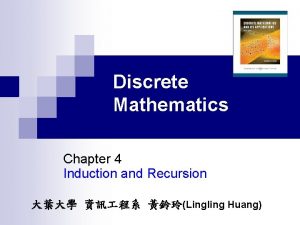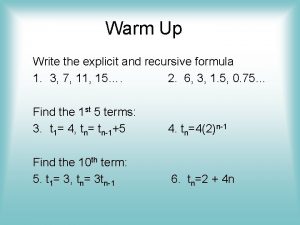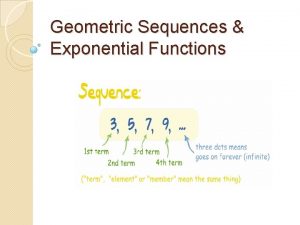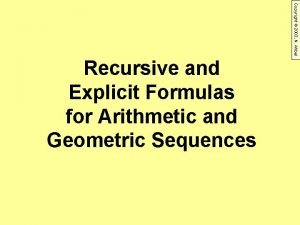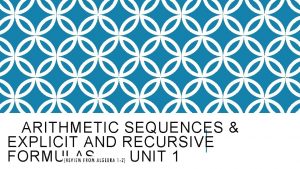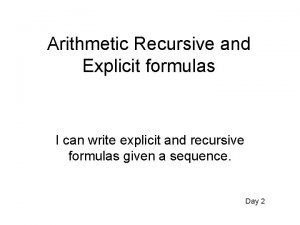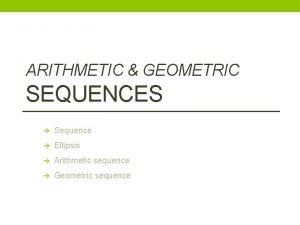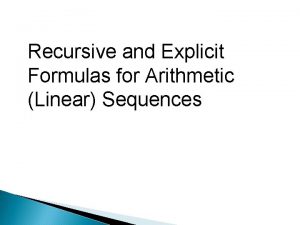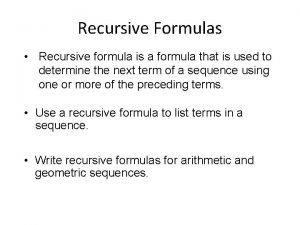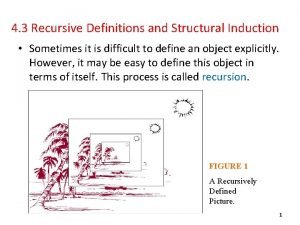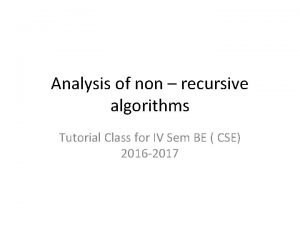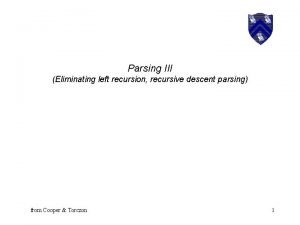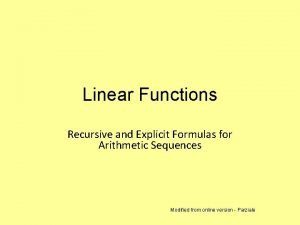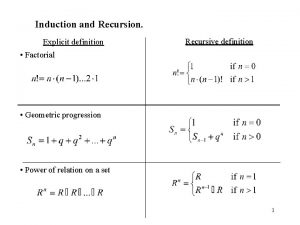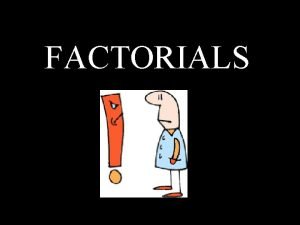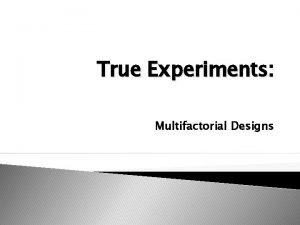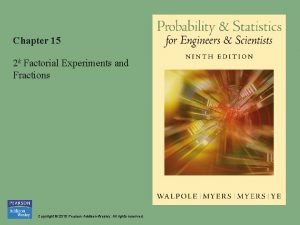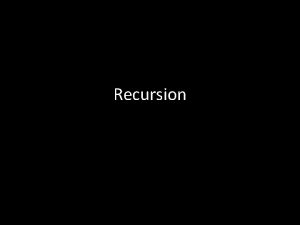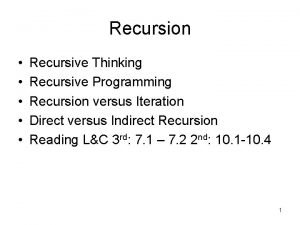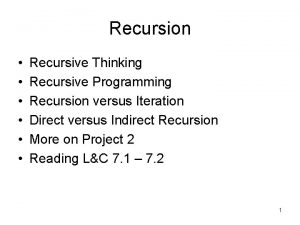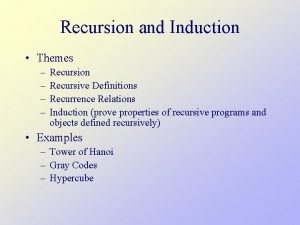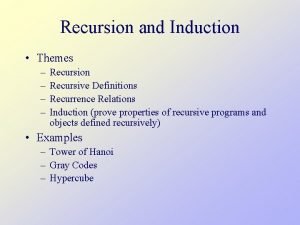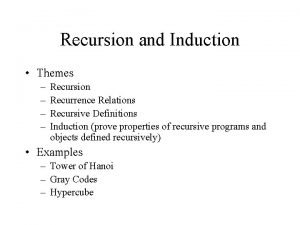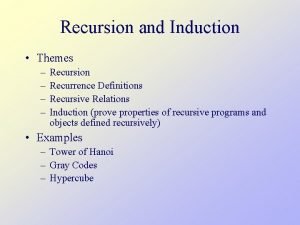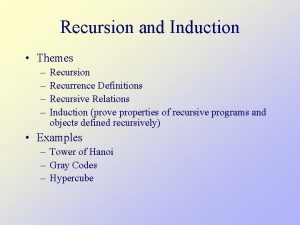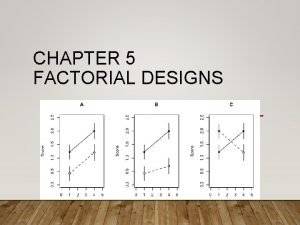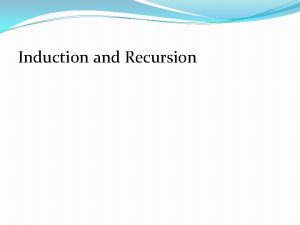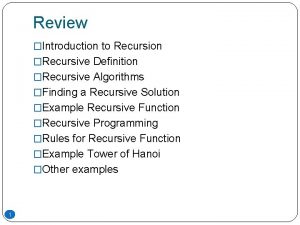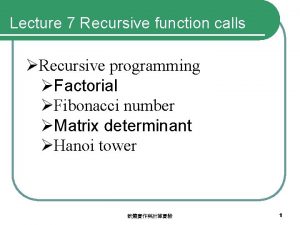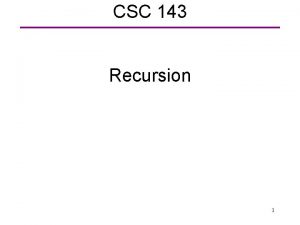Induction and Recursion Explicit definition Recursive definition Factorial

















- Slides: 17

Induction and Recursion. Explicit definition Recursive definition • Factorial • Geometric progression • Power of relation on a set 1

• The recursive definition of a function makes reference to earlier versions of itself. • The main connection between recursion and induction is that objects are defined by means of a natural sequence. • Induction is usually the best (possibly the only) way to prove results about recursively defined objects. 2

How to find a closed form for a recursively defined function? In general there is no ready to use recipe. Some simple cases are • Linear function of integer n: g 1(n) = an+b g 1(n+1) = a(n+1)+b= g 1(n) + a • Quadratic function of integer n: g 2(n) = an 2+bn+c g 2(n+1) = a(n+1)2+b(n+1)+c = g 2(n) +2 an+(a+b) 3

Example. Prove that for all positive integers m and n, Proof. Let m be arbitrary positive integer and then prove by induction on n 1. 1) Basis. n=1: (by recursive definition of Rm+1) 2) IH: Assume that for some k 1 we have IS: We need to prove that ……. . definition of composition …. . by IH …. association of composition ……. . definition of composition 4

Transitive closures again. Theorem. The transitive closure of R is Proof. Denote. We need to prove that S satisfies the definition of transitive closure, i. e. i) S includes R, R S ii) S is transitive iii) S is the smallest relation satisfying i) and ii) assume (x, y) S and (y, z ) S to prove that (x, z) S. (x, y) S implies that (x, y) Rn , n is some integer, n Z+. (y, z ) S implies that (y, z ) Rm, m is some integer , n Z+. (x, z) Rno Rm= Rn+m, by the previous Theorem. (x, z) S , since Rn+m S 5

iii) Suppose T is any relation, satisfying i) R T and ii) T is transitive. and prove that S T. By the definition of S as , it suffices to prove that for any n Z+ (Rn T) We are going to prove it by induction on n 1. 1) Basis: when n=1, R 1=R T by assumption. 2) IH: Assume that for n=k, where k is some integer, k 1, Rk T. IS: Need to prove Rk+1 T Suppose (x, y) Rk+1=Rko R (by definition of composition). It implies that there exists some z A, that (x, z) Rk and (z, y) R. . (x, z) Rk implies (x, z) T , because Rk T by IH. (z, y) R implies (z, y) T , because R T by assumption. (x, z) T and (z, y) T imply (x, y) T by transitive property of T. We proved by induction that for any n 1, Rn T. 6

Fibonacci Numbers The sequence named for Fibonacci (1202) is introduced in terms of rabbits. Suppose that every month a breeding pair of rabbits produce a pair of offspring. The offspring in turn start breeding two months later, and so on. Denote Fn the number of pairs in month n. Suppose you buy a pair of rabbits in month 1 (F 0=0, F 1=1) then you still have one pair in month 2 (F 2=1), but in month 3 they start breeding, F 3=2. The sequence begins 0, 1, 1, 2, 3, 5, 8, 13, 21, … You can observe, that in a month n you have all pairs from the previous month (n 1), plus offspring pairs for all pairs from month (n 2), i. e. : , n 2 7

So, Fibonacci numbers can be defined recursively: These numbers have numerous applications in CS, mathematics, theory of games. Let’s prove the closed formula for the sum for all integers n 0 Proof by induction on n 0. 1) Basis. Take n=0 and check that ? By the recurrent formula for n =2 we have so F 2 1=0 and F 0=0. 8

2) IH: Assume that the summation formula is correct for n=k, where k is some integer k 0, i. e. IS: We need to prove that …………by IH ……. . by recurrence formula for (k+3) >1 9

• Sometimes we need stronger assumption to prove IS. • It happens when to prove IS for (n +1) you need to refer not only to the previous n , but to smaller numbers. Strong Induction Principle: Let A N denote a subset that satisfies the following two properties: 1) 0 A; 2) if 0, 1, …k A, then k+1 A. Then A=N. So, Strong Induction differs from Induction Principle in step 2): IP 2) n 0 [P (n) P (n+1)] Strong Induction 2) n 0 [( m n P (m)) P (n+1)] 10

Example. Prove that every amount of postage of 12 cents or more can be formed using only 4 cent and 5 cent stamps. We are going to prove by induction on n 12, that any postage n = 5 i + 4 j, where integers i, j 0. As we proceed n n +1, we can not derive case n +1 from the case n (n+1) 5 (n+1) 4 n n +1 We can infer n+1 = 5 i + 4 j either from (n+1) 5 = 5(i 1) + 4 j or from (n+1) 4 = 5 i + 4(j 1) We need to prove an extended basis here, that is to prove the basis on more then one point. 11

Proof. 1) Basis (extended): check that we can form postage of 12, 13, 14, and 15 cents using only 4 c and 5 c stamps. 12=4 3; 13=5+ 4 2; 14=5 2+4; 15=5 3. 2) IH: Assume that any postage 12, … k, where k 15 can be made using 4 c and 5 c stamps (strong induction) IS Prove that conjecture is true for the postage k +1. By IH any postage greater or equal then 12 c and less or equal k can be formed using 4 c and 5 c stamps. In particular it is true for k 3. Together with one more 4 c stamp it gives k +1 postage. 12

Theorem. The following three principles are equivalent: (a) the Induction Principle; (b) the Strong Induction Principle; and (c) the Well-Ordering principle. Proof. It suffices to prove (a) (b), (b) (c), and (c) (a). We already did this 13

Proof of (a) (b): Let A N and A satisfies the two properties: (1) 0 A; and (2) if 0, 1, …k A then k+1 A. We need to prove A=N. To make use of Induction Principle we define the auxiliary set C={m| m N and 0, 1, …m A}. Thus, C A N (3). Since 0 A by (1), 0 C by the definition of C. If k C, that is, 0, 1, …k A, then by the property (2) of the set A, k+1 A, which implies that k+1 C, because 0, 1, …k, k+1 A. Thus, set C satisfies the properties of the Induction Principle, so C=N. Therefore A=N because of (3). 14

Proof of (b) (c): Assume B N and B (4). Suppose the Well-Ordering Principle is false, i. e. suppose B does not have the smallest element (5). Prove that this leads to contradiction to the Strong Induction Principle. Let A=N B (6). By (5) 0 B, thus 0 A by (6). If the numbers 0, 1, …k A, then these numbers do not belong to B. Then k+1 does not belong to B, because otherwise it would be the smallest element of B contradicting to (5). Thus, k+1 A and by the Strong Induction Principle A=N, which implies that B = by (6), contradicting to (4). So, (c) is proved. 15

Example. Prove that n Fn+1 0 1 2 3 4 5 6 7 1 1 2 3 5 8 13 21 for all n 5. 1 1. 5 2. 25 3. 375 5. 0625 7. 59375 11. 390625 17. 0859375 Basis 16

Proof by induction on n 5 that Fn+1>(3/2)n 1) Basis (extended) n=5: F 6=8>(3/2)5 = 7. 59375 n=6: F 7= 13>(3/2)6 = 11. 390625 2) IH : Assume that for all n=5, …k, where k is some integer k 6 we have Fn+1>(3/2)n (strong induction). IS : We need to prove inequality Fn+1>(3/2)n for n = k +1, i. e. Fk+2>(3/2)k+1 Fk+2= Fk+1+ Fk ……recursive definition > (3/2)k + (3/2)k 1 ……. IH for n=k and n=k 1 = (3/2)k 1 ((3/2)+1)……algebra = (3/2)k 1 (5/2) = (3/2)k 1 (10/4) > (3/2)k 1 (9/4) = (3/2)k 1 (3/2)2 = (3/2)k+1 17
 Induction and recursion discrete mathematics
Induction and recursion discrete mathematics To understand recursion you must understand recursion
To understand recursion you must understand recursion Recursive vs explicit formula
Recursive vs explicit formula Exponential function geometric sequences
Exponential function geometric sequences Explicit formula
Explicit formula Explicit and recursive formulas
Explicit and recursive formulas Recursive arithmetic formula
Recursive arithmetic formula Geometric recursive formula
Geometric recursive formula Linear recursive formula
Linear recursive formula Recursive formula definition
Recursive formula definition Recursive definitions and structural induction
Recursive definitions and structural induction Non recursive algorithm example
Non recursive algorithm example Left factoring algorithm
Left factoring algorithm Explicit formula
Explicit formula Explicit vs recursive
Explicit vs recursive Definition of factorial
Definition of factorial Mixed factorial design definition
Mixed factorial design definition 2k factorial experiments and fractions
2k factorial experiments and fractions
